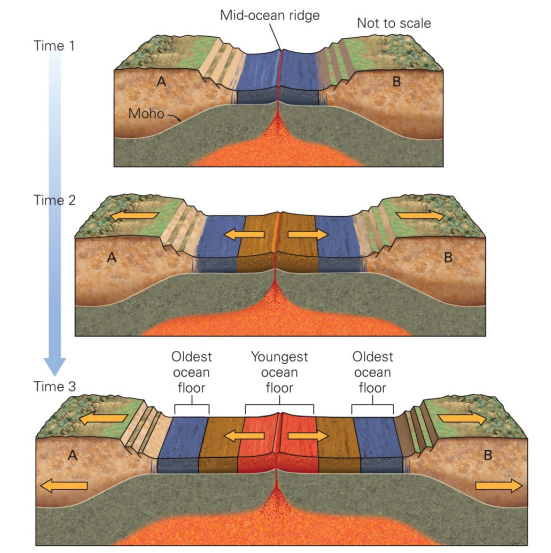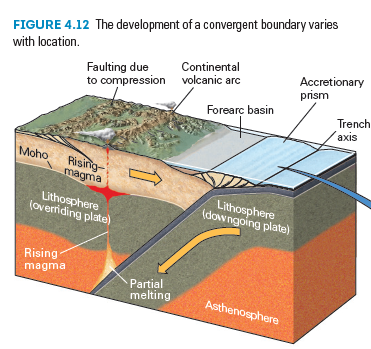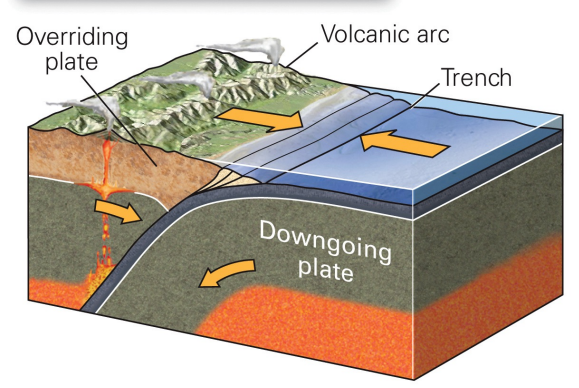Interlude C + Chapters 3-4
1/15
Earn XP
Name | Mastery | Learn | Test | Matching | Spaced |
|---|
No study sessions yet.
16 Terms
How do you define the tectonic plates and the lithosphere in terms of deformation behaviour and heat transport?
Tectonic plates are a part of the lithosphere (they are the upper crust). The lithosphere is rigid and cannot flow but is reflexive when put under the pressure of a load. The lithosphere is a conductor of heat (not a very good one but it is a conductor nonetheless)
What is the difference between the plates and the continents?
The difference between plates and continents are that plates contain parts of the ocean crusts as well but the continents are only a fraction of these plates (the exposed parts)
What are some pieces of evidence for continental drift?
glaciations in once-cold (now hot) places: The striations on the cliffs in places like India and Australia are evidence of glaciers due to the till they deposited. As glaciers only form at high latitudes, they could have only been formed if those places had been moved. These striations also had evidence of the direction of water movement and these movements only make sense if the continents were adjacent to one another
discovery of fossils (from the Mesozoic era): These diagnostic animals and plants lived (and could only travel) on land if they were adjacent to one another. Therefore, it the same fossils were discovered on continents now oceans apart, Wegener hypothesised this is because the continents were adjacent
matching rocks from ancient (Proterozoic) mountain belts and ancient (Archean) crust: The same rock composition found on edges of different continents suggest that they formed along the same fault on a supercontinent
what is plate tectonics and its principles?
Plate tectonics is the kinetic theory of movements and speeds of the rigid lithospheric plates. The basic principles are:
the plates are part of the lithosphere (100-150km thick of Earth’s crust and lithospheric mantle). Continents are not plates but are rather located on top of them and these do not get smashed or deformed. When plates move, the continents move as well (hence, the idea of ‘continental drift’)
the boundaries of these plates are defined by locations of earthquakes
the Lithospheric plates are relatively rigid and cannot flow
because of Plate tectonics, the map of the Earth changes over long periods of time
what are plate boundaries?
boundaries between the plates
locations for earthquakes
what is the lithosphere?
about 100-150km thick and contains the crust and a section of the (lithospheric) mantle
relatively rigid and cannot flow
elastic (recoverable deformation) - it will bend or give way when a load is placed on the Earth’s surface (breaks for faults or earthquakes)
lithosphere conducts heat (moves through the rock) (very poor conductor of heat)
what is the asthenosphere?
underneath the lithosphere and contains the rest of the mantle
relatively soft and able to flow over long time periods
it will flow out of the way when a load is dropped → plastic (permanent deformation)
convects heat from the core (very efficient convector)
describe the rock cycle
igneous rock → (through erosion, transportation and deposition) → sedimentary rock → (through burial and heating) → metamorphic rock → (through melting) → igneous rock

What are three different plate boundaries and how do these plate boundaries fit into the rock cycle?
divergent boundaries: when two (oceanic) plates move apart from each other by seafloor spreading. New plate is formed
igneous rocks form at mid-ocean crust as molten rock from the mantle escapes and cools around mid-ocean ridges
convergent boundaries: where two plates (at least one is oceanic) move towards each other. One plate is ultimately consumed underneath the other in a process called subduction
igneous, sedimentary, metamorphic rocks
transform boundaries: two plates slides past each other on a vertical fault. No old plate is consumed and no new plate is formed
sedimentary and metamorphic rocks
divergent boundaries
Two plates move apart
New plate is formed
The temperature decreases further from the ridge
The lithosphere thickens further from the ridge (mantle gets thicker, but crust stays the same)

convergent boundaries
two plates (at least one is oceanic) move towards each other
volcanic arcs form behind the plate boundary
Oceanic island arc is formed if the overriding plate is oceanic
with the downgoing rock, there’s a lot of sedimentary rock
also metamorphic and igneous rocks

transform boundary
two plates slide past each other on a vertical fault
e.g. San Andreas fault
transform faults connect different portions of the spreading centre where new oceanic crusts are being made, offsetting a section of the lithosphere

how are volcanoes made?
when you drag down seafloor in a subduction zone, it releases water → melts mantle → melt is buoyant and rises through the crust → volcano
which is why if you ever find a volcano, you will find a subduction zone >100km underneath it
what happens at mid-ocean ridges?
temperature decreases further away from the ridge + pressure decreases + thickness of oceanic crust stays the same
igneous rock is formed (from magma underneath/molten material) → crust is youngest on the ridge + gets older the further away you are from the ridge

subduction zones
places in a convergent boundary where one plate is consumed underneath the other one
the subducting plate is colder and heavier than the mantle so it gets dragged down
only oceanic plates can be subducted because the continental crust is too light to subduct
hence why they have short lifespans because they get eaten

what kinds of rocks can be formed with transform boundaries?
if there’s squishing involved → sedimentary rock and underneath → metamorphic rock